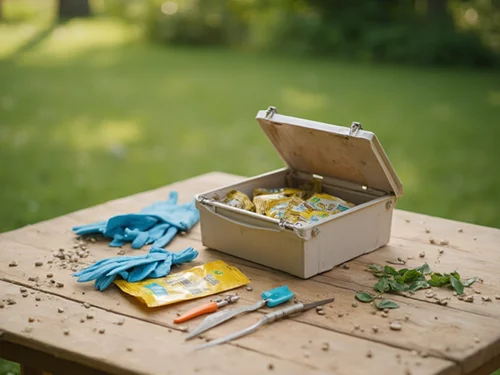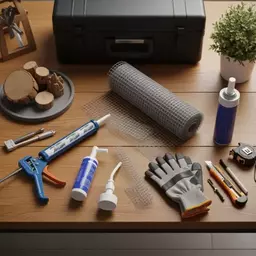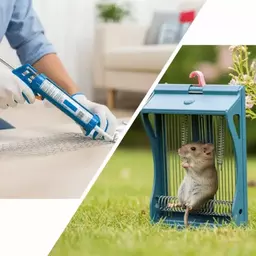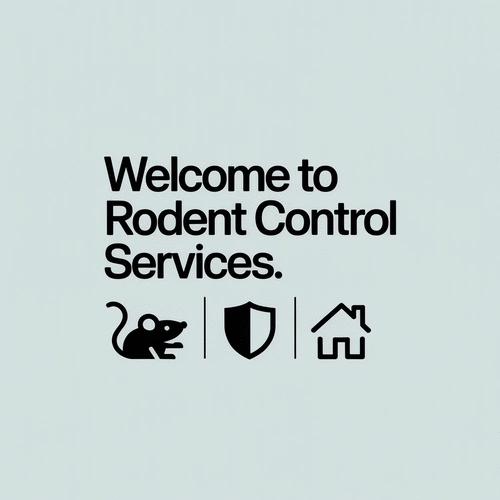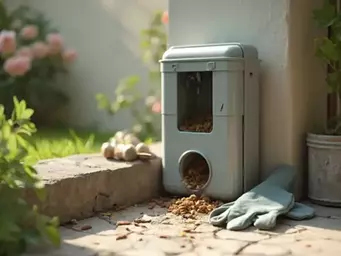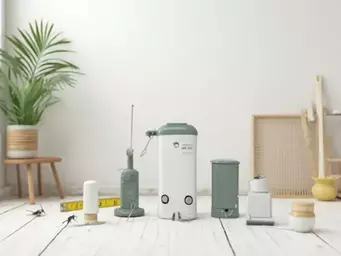What if you could take control of pest management in your own home or business, saving money while ensuring a safe environment for your family? DIY rodent baiting empowers you to manage pest populations effectively, using tailored solutions that meet your specific needs.
What You Will Learn
- DIY rodent baiting provides a cost-effective solution compared to commercial pest control options.
- Customizing bait stations for specific rodent species increases the effectiveness of your pest management strategy.
- Sustainable practices, such as using recycled materials and non-toxic baits, contribute to environmentally friendly pest control.
- Understanding the common rodent species in your area helps in developing targeted baiting strategies for effective control.
- Long-term maintenance of a rodent-free environment involves monitoring, assessing bait effectiveness, and adapting methods as needed.
DIY Rodent Control: Benefits, Materials & Risks
This visual summarizes key aspects of DIY rodent control, highlighting the benefits of homemade bait stations, essential materials, and associated health risks.
Benefits of DIY Bait Stations
- ✓ Cost-Effectiveness
- ✓ Customization
- ✓ Sustainability
Save money and tailor solutions to specific rodent species.
Essential Materials & Bait Types
- ABS/PVC Pipes
- Recycled Materials
- Peanut Butter (Mice)
- Grains (Various)
- Non-Toxic Options
Durable materials and targeted baits for effective control.
Health Risks of Rodent Infestations
- ⚠ Hantavirus (Respiratory)
- ⚠ Leptospirosis (Bacterial)
- ⚠ Salmonella (Food Poisoning)
Prompt action is crucial to minimize serious health threats.
Common Rodent Species to Target
- • Mice (Small, quick, homes/offices)
- • Rats (Larger, intelligent, challenging)
- • Squirrels (Outdoor, attics/roofs)
Tailor your approach to effectively manage specific rodent types.
Understanding DIY Rodent Baiting for Effective Pest Control
Have you ever considered how DIY rodent baiting can play a crucial role in your pest control strategy? This method allows you to create your own bait stations tailored to your specific needs. By understanding the fundamentals of DIY baiting, you can enhance your ability to manage rodent populations effectively in both residential and commercial spaces.
DIY rodent baiting not only promotes a proactive approach to pest management, but it also helps you stay in control of the materials and techniques used. As someone who has worked with various pest issues, I understand the importance of having reliable tools at your disposal!
What is DIY Rodent Baiting?
DIY rodent baiting involves creating bait stations using readily available materials and attracting substances designed to lure rodents like mice and rats. It’s a practical approach that empowers you to manage pest problems before they escalate. By setting up bait stations, you can monitor rodent activity and determine effective control measures quickly.
This method is particularly valuable because it combines education with action. You’ll not only learn about the types of rodents in your area but also develop hands-on skills in managing them—an effective way to foster a rodent-free environment.
The Benefits of Creating Your Own Bait Stations
- Cost-Effectiveness: Building your bait stations can significantly save you money compared to purchasing commercial solutions.
- Customization: DIY baiting allows you to tailor your bait and stations based on the specific rodent species you’re targeting.
- Sustainability: Using sustainable materials and methods contributes to environmentally friendly pest management practices.
Creating your own bait stations not only offers financial savings but also enhances your knowledge about rodent behavior and effective control methods. By using materials you can easily find or recycle, you’re contributing to a more sustainable approach to pest management!
Common Rodent Species to Target with DIY Baiting
When considering DIY baiting, it’s essential to identify the common rodent species that might invade your space. Typically, you’ll want to focus on:
- Mice: Small, quick, and often found in homes and offices.
- Rats: Larger than mice, these can be more challenging to manage due to their size and intelligence. Educational resources, such as those from the STOP Pests in Housing program, offer valuable insights into controlling rat populations effectively.
- Squirrels: While more common outdoors, they can invade attics and roofs looking for shelter.
By understanding which species you’re dealing with, you can create tailored traps and bait that align with their habits and preferences. This targeted approach increases your chances of successfully managing rodent populations!
Essential Materials for Building Your Bait Stations
Choosing the Right Materials for Homemade Bait Stations
When it comes to constructing effective bait stations, selecting the right materials is key. Popular choices include ABS and PVC pipes due to their durability and ease of access. These materials can withstand the elements and prevent rodents from easily dismantling your efforts. For detailed instructions on building bait stations, the University of Nebraska-Lincoln Extension provides comprehensive guides.
Additionally, using recycled materials can further enhance the sustainability of your pest management strategy. Choosing materials that are both effective and environmentally friendly aligns with our mission at Rodent Control Services to promote safe and sustainable pest management solutions!
Recommended Rodent Bait Types for Different Species
Selecting the right bait is crucial for successful rodent control. Here are some effective bait options:
- Peanut Butter: Mice adore it! A little smear on your traps can be very effective.
- Grains: Rice or oats can attract a variety of rodents, especially when mixed with other attractants.
- Commercial Baits: There are many toxic and non-toxic options available in stores that can be effective, depending on your specific needs.
Choosing the right bait will depend on the species you are targeting, so it's essential to tailor your approach accordingly. This thoughtful consideration ensures that your efforts yield the best outcomes in keeping your spaces rodent-free!
Understanding Attractants and Non-Toxic Bait Options
When selecting bait, consider not only what attracts rodents but also the safety of the options you choose. Non-toxic bait solutions, such as whole grains or natural peanut butter, can effectively lure rodents without posing risks to pets and children. This approach resonates with my commitment to safety in pest management. Resources from organizations like the University of Missouri Extension offer valuable information on various attractants and baiting strategies.
Understanding which attractants work best for different rodent species will make your DIY rodent baiting more effective while ensuring a safe environment for your loved ones. Choosing the right bait is a step towards an effective pest control strategy!
We Want to Hear From You!
What has been your experience with DIY rodent baiting? Have you found certain materials or techniques more effective than others? Share your thoughts below:
Frequently Asked Questions About DIY Rodent Baiting
- What are the main benefits of DIY rodent baiting?
- DIY rodent baiting offers cost-effectiveness, customization to specific rodent species, and promotes sustainable pest management practices by using readily available or recycled materials.
- What materials are best for building homemade bait stations?
- Durable materials like ABS and PVC pipes are highly recommended due to their longevity and ability to withstand environmental factors. Recycled materials can also be effectively used to enhance sustainability.
- Which types of bait are most effective for DIY rodent control?
- Peanut butter is particularly effective for mice, while grains (like rice or oats) can attract a wider variety of rodents. Both toxic and non-toxic commercial baits are also available, depending on your safety requirements.
- What health risks are associated with rodent infestations?
- Rodents can carry serious diseases such as Hantavirus (affecting respiratory systems), Leptospirosis (a bacterial infection), and Salmonella (causing food poisoning). Prompt action in pest control is crucial to mitigate these risks.
- How can DIY rodent baiting be made more eco-friendly?
- To make DIY baiting eco-friendly, use natural ingredients like peanut butter or whole grains, repurpose materials for bait stations, and prioritize non-toxic bait options to ensure safety for children and pets.
Long-term Considerations for DIY Rodent Control
When it comes to maintaining a rodent-free environment, understanding the long-term implications of your DIY rodent baiting solutions is crucial. Not only do we want to address immediate infestations, but we also aim to create sustainable practices that will keep your home or business free from these pesky creatures for years to come. This section explores the cost-effectiveness of homemade bait stations, the importance of eco-friendly practices, and the health risks associated with rodent infestations.
Assessing the Cost-Effectiveness of Homemade Bait Stations
One of the most appealing aspects of DIY rodent baiting is its potential for cost savings. When I compare homemade solutions to commercial options, it's clear that building your own bait stations can be a budget-friendly choice. Here are a few points to consider:
- Material Costs: Utilizing inexpensive materials like PVC or ABS pipes can significantly reduce the overall expense.
- Customizable Solutions: DIY bait stations can be tailored to your specific needs, allowing you to use only what is necessary for your situation.
- Long-term Savings: While the initial investment may require some effort, the durability and effectiveness of homemade stations can reduce the need for repeat purchases.
In my experience, the financial benefits of creating your own bait stations often outweigh the costs associated with store-bought options. This allows you to invest your savings in other essential areas of pest management.
Eco-Friendly Practices in Rodent Control
As a pest management advocate, I emphasize the importance of sustainability in all our rodent control solutions. DIY baiting not only saves money but also promotes eco-friendly practices. Here are some sustainable habits to adopt:
- Natural Ingredients: Consider using ingredients like peanut butter or grains, which are not only effective but also less harmful to the environment.
- Recycled Materials: Utilize leftover materials or repurposed items to create your bait stations, minimizing waste.
- Non-Toxic Solutions: Focus on bait options that are safe for children and pets, ensuring a safer home environment.
By integrating eco-friendly practices into your rodent control strategies, you're not only protecting your space but also contributing to a healthier planet!
Understanding the Health Risks Associated with Rodent Infestations
It's essential to recognize the potential health risks posed by rodent infestations. Rodents can carry various diseases that may impact both humans and pets. Here are some key health concerns:
- Hantavirus: This virus can lead to severe respiratory issues if contracted through contact with rodent droppings or urine.
- Leptospirosis: Transmitted through contaminated water or soil, this bacterial infection can cause flu-like symptoms and serious complications if left untreated.
- Salmonella: Rodents can carry this bacteria, which can contaminate food sources and lead to food poisoning.
Implementing effective pest control measures, such as DIY baiting, is vital for minimizing these risks. Remember, addressing rodent problems promptly is crucial for protecting your health and well-being.
Recap of Key Points
Here is a quick recap of the important points discussed in the article:
- DIY Rodent Baiting: An effective method for managing rodent populations by creating customized bait stations.
- Benefits: Cost-effectiveness, customization based on specific rodent species, and sustainable practices.
- Common Rodent Species: Focus on mice, rats, and squirrels to tailor your baiting strategy.
- Essential Materials: Use durable materials like ABS and PVC, and consider recycling for sustainability.
- Recommended Baits: Peanut butter, grains, and commercial baits can effectively attract different rodent species.
- Health Risks: Be aware of diseases linked to rodent infestations, such as hantavirus and salmonella.
- Long-term Practices: Focus on eco-friendly methods and cost-effectiveness to maintain a rodent-free environment.

